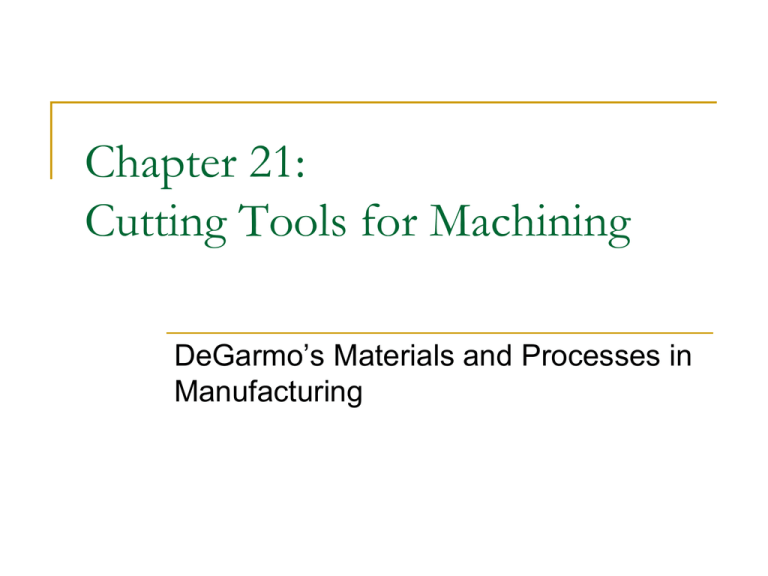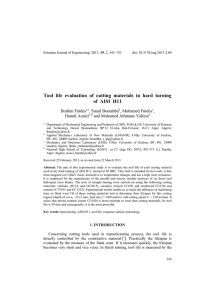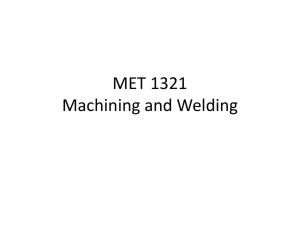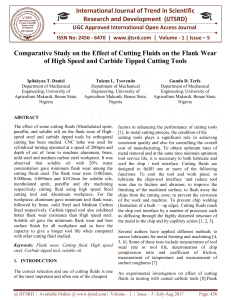ch21 - lecture
advertisement

Chapter 21: Cutting Tools for Machining DeGarmo’s Materials and Processes in Manufacturing 21.1 Introduction Improvements in Cutting Tools FIGURE 21-1 Improvements in cutting tool materials have led to significant increases in cutting speeds (and productivity) over the years. Selection of Cutting Tool Materials FIGURE 21-2 The selection of the cuttingtool material and geometry followed by the selection of cutting conditions for a given application depends upon many variables FIGURE 21-3 The typical relationship of temperature at the tool–chip interface to cutting speed shows a rapid increase. Correspondingly, the tool wears at the interface rapidly with increased temperature, often created by increased speed. FIGURE 21-4 Distribution of heat generated in machining to the chip, tool, and workpiece. Heat going to the environment is not shown. Figure based on the work of A. O. Schmidt. FIGURE 21-5 There are three main sources of heat in metal cutting. (1) Primary shear zone. (2) Secondary shear zone tool–chip (T–C) interface. (3) Tool flank. The peak temperature occurs at the center of the interface, in the shaded region. FIGURE 21-6 (a) Hardness of cutting materials and (b) decreasing hardness with increasing temperature, called hot hardness. Some materials display a more rapid drop in hardness above some temperatures. (From Metal Cutting Principles, 2nd ed. Courtesy of Ingersoll Cutting Tool Company.) 21.2 Cutting-Tools Materials FIGURE 21-7 The most important properties of tool steels are: 1. Hardness—resistance to deforming and flattening 2. Toughness—resistance to breakage and chipping 3. Wear resistance—resistance to abrasion and erosion. Properties of Cutting Tool Materials Cemented Carbide Inserts FIGURE 21-9 P/M process for making cemented carbide insert tools. Boring Head FIGURE 21-10 Boring head with carbide insert cutting tools. These inserts have a chip groove that can cause the chips to curl tightly and break into small, easily disposed lengths. Triple Coated Carbide Tools FIGURE 21-11 Triplecoated carbide tools provide resistance to wear and plastic deformation in machining of steel, abrasive wear in cast iron, and built-up edge formation. Triple Coated Carbide Tools FIGURE 21-11 Triple-coated carbide tools provide resistance to wear and plastic deformation in machining of steel, abrasive wear in cast iron, and built-up edge formation. Cutting Tool Material Properties FIGURE 21-12 Comparison of cermets with various cutting-tool materials. Polycrystalline Diamond Tools FIGURE 21-13 Polycrystalline diamond tools are carbides with diamond inserts. They are restricted to simple geometries. Cost Comparison Application Comparison 21.3 Tool Geometry Tool Geometry Terminology FIGURE 21-14 Standard terminology to describe the geometry of singlepoint tools: (a) three dimensional views of tool, (b) oblique view of tool from cutting edge, (c) top view of turning with singlepoint tool, (d) oblique view from shank end of singlepoint turning tool. 21.4 Tools Coating Processes CVD Process FIGURE 21-15 Chemical vapor deposition is used to apply layers (TiC, TiN, etc.) to carbide cutting tools. PVC Arc Process FIGURE 21-16 Schematic of PVC arc evaporation process 21.5 Tool Failure and Tool Life Tool Failure FIGURE 21-17 Tools can fail in many ways. Tool wear during oblique cutting can occur on the flank or the rake face; t = uncut chip thickness; kt = crater depth; wf = flank wear land length; DCL = depthof-cut line. 21.6 Flank Wear Tools Wear FIGURE 21-18 Tool wear on the flank displays a random nature, as does tool life. Wf = flank wear limit value. Typical Tool Wear Curves FIGURE 21-19 Typical tool wear curves for flank wear at different velocities. The initial wear is very fast, then it evens out to a more gradual pattern until the limit is reached; after that, the wear substantially increases. Taylor Tool Life Curves FIGURE 21-20 Construction of the Taylor tool life curve using data from deterministic tool wear plots like those of Figure 21-17. Curves like this can be developed for both flank and crater wear. Tool Life Plots FIGURE 21-21 Log-log tool life plots for three steel work materials cut with HSS tool material. Tools Life FIGURE 21-22 Tool life viewed as a random variable has a log normal distribution with a large coefficient of variation. Tool Life Data FIGURE 21-23 Tool life test data for various coated drills. TiN-coated HSS drills outperform uncoated drills. Life based on the number of holes drilled before drill failure. Machinability Rating FIGURE 21-24 Machinability ratings defined by deterministic tool life curves. 21.7 Cutting Fluids Cutting Fluid Contaminants Fluid Recycling System FIGURE 21-25 A well-designed recycling system for coolants will return more than 99% of the fluid for reuse. 21.8 Economics of Machining Cost Comparison Cost per Unit FIGURE 21-26 Cost per unit for a machining process versus cutting speed. Note that the “C” in this figure and related equations is not the same “C” used in the Taylor tool life (equation 21-3).











